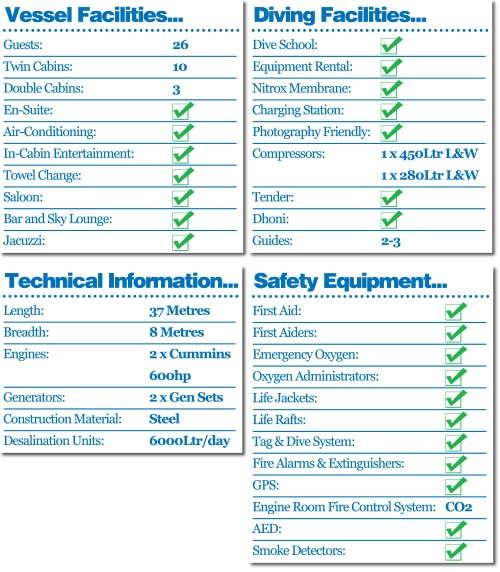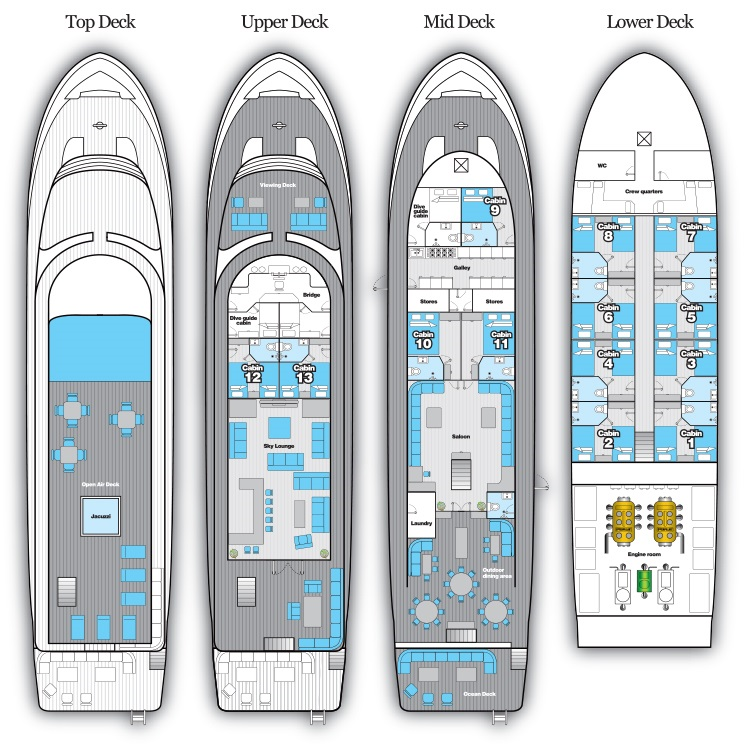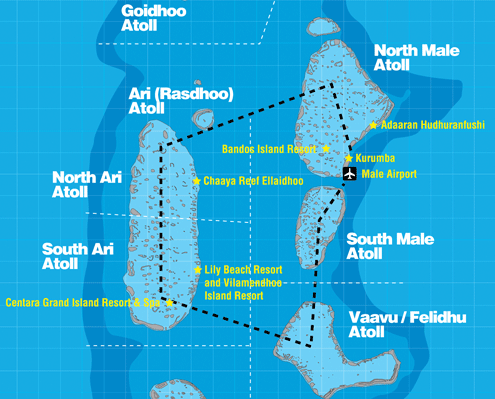The first blue o two fleet vessel in the Maldives, M/Y Blue Voyager was built specifically for divers and originally sailed in the Red Sea. She underwent a major refurbishment in 2015 before relocating to the Maldives with further updates in the summer of 2016 and 2017. M/Y blue Voyager welcomes 26 divers on board with spacious modern comfort, providing a great Maldivian diving experience.
M/Y blue Voyager is a 37-metre, steel hulled vessel that boasts three roomy double cabins and ten twin cabins. She features an indoor dining area, a bar and sky lounge, as well as a Jacuzzi. A shaded outdoor lounge area can be found on the Mid Deck, plus four different sun decks: a viewing deck located at the front of both the Mid Deck and Upper Deck, an open-air deck on the Top Deck and an ocean deck at the stern of the boat, all providing comfortable seating and loungers.
The ocean deck is a unique feature allowing guests to relax in the open air while close to the water. On many evenings the flood lights will illuminate the water just off the ocean deck to attract plankton which brings the manta rays and whale sharks. There have been many close sightings of feeding mantas and whale sharks, have your camera ready and you might even get splashed!
One of the most outstanding features of M/Y Blue Voyager is the custom-built, Blue Shadow. This brand new 19-meter dhoni is spacious, fast, and equipped with all the modern conveniences that divers want. Each diver has their own station with plenty of space store their gear and kit up, and the dhoni crew are ready to assist. During the journeys to and from the dive sites, you can ascend the small stairs to the top deck to enjoy the sun and stunning views. There is a toilet with shower located inside the main deck plus two handheld showers on the back deck, and separate camera and equipment rinse tanks. A fast engine, two generators and two compressors with a nitrox membrane system mean you will enjoy a first-rate diving experience in the Maldives. This vessel provides ample space for all guests on board due to the seven different lounging areas spread across three decks. It will never feel crowded, in fact many guests enjoy the social atmosphere that provides a comfortable setting for individuals and groups alike. We know most divers are only in their cabins to sleep so we've made sure the rest of the vessel is as comfortable and spacious as possible. However, when you do need some down time in your cabin, you have your own entertainment system with TV, films, and USB port. Each cabin has air conditioning, ensuite facilities, and plenty of storage space. Extra towels are already stocked in your cabin, with separate towels for the dive deck. If you enjoy having an ocean view, consider upgrading to a Premium Double Cabin (Mid Deck) or Premium Twin Cabin (Upper Deck) with large windows as well as all-new interior furnishings.
The Chef and Assistant Chef will delight you with delectable local and Western cuisine. Special dietary requests are well catered for, including vegetarian, vegan and gluten-free (with advance notification please). Breakfast and lunch are served as buffets, and dinner is served family-style for each of the tables in the air-conditioned dining area, with the crew ready to assist and provide refills as needed. You'll never go hungry with the abundant spread including appetizers, mains, desserts, snacks between dives, and the most delicious, fresh and local tropical fruits. The barman is on hand to serve beer, wines and freshly-made cocktails which are simply added to your tab for onboard payments.


Best of the Central Atolls
9-12 Night Itineraries
Typical Day at Sea:
06:30 - Tea, coffee and biscuits
07:00 - Dive 1 followed by full breakfast
11:00 - Dive 2 followed by lunch
15:00 - Dive 3 followed by homemade cakes and snacks
19:30 – Dinner
**PLEASE NOTE** The dive sites below are just an example of the route taken and are not guaranteed. All dive sites are subject to weather conditions and local seasonal knowledge and the final route taken is at the absolute discretion of the captain and dive guides.
Guraidhoo Kandu - South Male Atoll
Since the eastern side of the channel is open ocean, large predatory fish can regularly be spotted here. This site is famous for sightings of sharks, schools of eagle rays and the occasional sail fish and hammerheads. The best condition to do the dive is when the current is flowing into the atoll. The dive begins on the outer reef following the current into the atoll. Most of the pelagic species can be observed on the eastern side, where the reef drops off into the deep ocean. At the end of the dive in the channel, along the reef you can find overhangs with plenty of soft coral growth and small fish.
Kandooma Thila - South Male Atoll
Located in a channel, the reef is subject to strong currents at times. The ocean currents carry lot of nutrients to the reef, supporting an abundance of sea life. The site is well renowned for the soft coral growth, turtles, diverse fish life and invertebrates found on the reef. At the reef slope you may find sharks and eagle rays.
Mulaku Kandu - Meemu Atoll
The north east is peppered with submerged pinnacles covered predominantly in soft corals, whilst the west will see you surrounded by jacks and snappers. Keep an eye open for sharks and rays at 30m!
Fish Head - North Ari
Fish Head also known as Shark Point or Mushimasmingili Thila, fits the classic definition of a thila - a large isolated flat top reef rising sharply from the inner atoll floor at 40m to 50m to around 10m from the surface. It is one of the best sites for seeing sharks. Features a series of caves and overhangs in between where you can see thousands of blueline snapper against a backdrop of black coral bushes and large gorgonians.
Rasdhoo Madivaru - Rasdhoo
Rasdhoo Madivaru Corner is located in the corner of the channel into the atoll. Madivaru is famous amongst seasoned divers of the Maldives. It has one of the most spectacular and confusing reef formations found in Ari Atoll. Hammerhead sharks emerge in big numbers just before sunrise swimming in large groups. Dolphins, dog tooth tunas, along with schools of black snapper are seen at the reef edge during the early hours. Divers get an opportunity to view white tip reef sharks, pelagic, trevally, little tunas, jacks, ribbon eels, fish leaves tunas, Napoleon wrasse and barracudas. Experience the thrilling scuba diving adventure amongst fine coral formations with the highest underwater visibility.
Lhaviyani
Excellent channel diving in the north with sites closely located together. Lhaviyani Atoll hosts some of the Maldives wreck diving opportunities, including the two coral encrusted wrecks at 'The Shipyard' and the exhilarating drift dive of the Kuredu Express. A site for the more experienced diver.
Hanifaru Bay - Baa
Hanifaru Bay is a marine protected uninhabited island located in the Baa Atoll of the Maldives Islands. Its size is no greater than that of a football field and yet it has become one of the hottest spots on the planet for underwater photographers. The reason for this modern day phenomenon of underwater diversity is because plankton blooms between the months of May and November - a very unusual phenomenon - attracting manta rays by the hundreds. At any one time at Hanifaru Bay, there can be up to 200 manta rays feeding off the coral reefs as well as plenty of whale sharks which do the same! Hanifaru Bay has become the world's largest manta ray feeding destinations. PLEASE NOTE: From January 2012 scuba diving is not permitted in Hanifaru Bay, however you will be able to snorkel in this area for a $20 fee (per person for approx 45mins).
Dhigala Haa - Baa Atoll
This beautiful thila in Baa Atoll is easily circumnavigated in one dive and is a favorite for shark sightings, where you can possibly see at least 6 grey reef sharks at one time. Once heavily fished, it is now a protected marine sanctuary and the fish life is prolific and varied with blue fin jacks, fusilier, blue striped and humpback snapper, batfish and schools of barracuda.

Pelagic Encounters
7 Night Itinerary
Dive sites: North Male - Ari - Vaavu - South Male
Number of dives: Up to 3 dives a day
Ports: Male/Male
On this itinerary, you travel further south to Vaavu with the purpose of seeking out the larger pelagics. More channel diving is offered to maximize your chances of 'big fish' encounters and manta cleaning stations are also visited.
QUALIFICATION NEEDED: You must be certified to dive to a depth of 30 meters as well as be experienced and comfortable with diving in medium to strong currents. Please refer to our itinerary checklist for additional information. If you have Open Water certification and experience with currents, we strongly suggest you complete Advanced Open Water or Deep Diver Adventure Dive either before or during your holiday, so you can maximize your diving experience on board.
**PLEASE NOTE** the itinerary below is just an example of the route taken and the order and dive sites are not guaranteed. All dive sites are subject to weather conditions and local seasonal knowledge and the final route taken is at the absolute discretion of the captain and dive guides.
Day 1 - Check dive (N. Male), Kuda Girri Wreck (S. Male)
Day 2 - Miyaru Faru / Kandooma Thila (S. Male), Miyaru Kandu / Dhevana Kandu (Vaavu) and Golden Wall / Fotheyo (Vaavu)
Day 3 - Fotheyo /Hurahu Kandu (Vaavu), Rakeedhu / Vattaru (Vaavu)
Day 4 - Kudarah Thila / Broken Rock (S. Ari), Maamingili Beyru / Holiday Beyru (S. Ari) and Bodu Finolhu / Beyru Thila (S. Ari)
Day 5 - Rangali Madivaru/Madivaru Caves (S. Ari), Matchafushi Wreck / Rangali Madivaru (S. Ari) and Gaaviyamas Thila / Matchafushi Wreck (S. Ari)
Day 6 - Omadhoo Thila / Vilamendhoo Thila (S. Ari), Feydhoo Wall / Kuda Haa (N. Male) and Back Faru (N. Male). Please note the final day usually offers 1 or 2 dives in the morning, in order to allow 24 hours before flying.
Itinerary Highlights:
Fish Head
North Ari Fish Head also known as Shark Point or Mushimasmingili Thila, fits the classic definition of a thila - a large isolated flat top reef rising sharply from the inner atoll floor at 40m to 50m to around 10m from the surface. It is one of the best sites for seeing sharks. Features a series of caves and overhangs in between where you can see thousands of blueline snapper against a backdrop of black coral bushes and large gorgonians.
Miyaru Faru
Unsurprisingly given that 'miyaru' means shark in Dhivehi, sharks feature prominently at this North Male spot! At around 30 metres there is an overhang which can shield you from the strength of the passing current, and with an incoming current the visibility can be excellent and the parade of pelagic and local residents, impressive. You might see a number of grey reef sharks as well as barracuda, kingfish and tuna. Large groups of eagle rays and their larger cousins, the manta rays, are often seen here, filter feeding in the plankton-rich water.
Fotteyo Kandu
Many scuba divers consider Fotteyo Kandu (Vaavu Atoll) to be the best dive site in the Maldives and it is also rated among the top 5 dive sites in the world. The mouth of the channel is exposed to the ocean and during the north east monsoon when the currents are incoming, a good variety of fish species gather at the entrance to the channel. Animals commonly spotted here include grey reef shark patrolling the channel mouth, jack and tuna in the deeper water, schools of midnight snappers and red snapper form in huge groups. The wall features caves, overhangs and swim-throughs at different depths. These caves and overhangs are filled with a colorful yellow color like soft coral, deeper caves and overhangs are filled with huge bushes of black corals.
Kandooma Thila
Shaped like a teardrop, Kandooma Thila is one of the most spectacular dives in the South Male Atoll, for scenery as well as for prolific fish life.
Guraidhoo Kandu South
Since the eastern side of this South Male channel is open ocean, large predatory fish can regularly be spotted here. This site is famous for sightings of sharks, schools of eagle rays and the occasional sail fish and hammerheads. The best condition to do the dive is when the current is flowing into the Atoll. The dive begins on the outer reef following the current into the atoll. Most of the pelagic species can be observed on the eastern side, where the reef drops off into the deep ocean. At the end of the dive in the channel, along the reef you can find overhangs with plenty of soft coral growth and small fish.